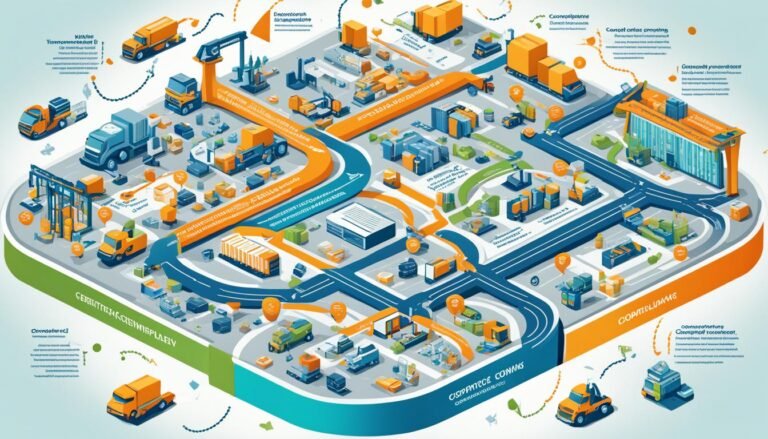Decentralized Finance (DeFi): A New Financial System?
Did you know that the global DeFi market reached a staggering $67.9 billion in total value locked as of 2021? This surprising statistic highlights the rapid growth and immense potential of decentralized finance (DeFi) as a disruptive force in the financial industry.
DeFi is revolutionizing the traditional centralized banking system by utilizing blockchain technology and cryptocurrencies to create a new financial system. It aims to eliminate intermediaries, increase accessibility, and promote transparency and autonomy in financial transactions.
In this article, we will explore what DeFi is, how it works, its goals and disadvantages, its relationship with Bitcoin, the concept of Total Value Locked (TVL), and its future implications. We will also discuss the risks and downsides associated with DeFi and the key takeaways to gain a better understanding of this groundbreaking financial technology.
Key Takeaways:
- Decentralized finance (DeFi) challenges the centralized banking system by empowering individuals through blockchain technology and cryptocurrencies.
- DeFi uses secure distributed ledgers to remove third parties and intermediaries from financial transactions.
- Peer-to-peer financial networks and blockchain technology form the foundation of DeFi, offering security, transparency, and autonomy.
- The goals of DeFi include enabling peer-to-peer transactions, increasing accessibility, reducing fees, and providing high-interest rates.
- Despite its advantages, DeFi faces challenges such as security vulnerabilities, regulatory considerations, and scalability.
What Is Decentralized Finance (DeFi)?
Decentralized finance (DeFi) is a revolutionary financial technology that leverages secure distributed ledgers to transform traditional financial transactions. Built upon the fundamental components of cryptocurrencies, blockchain technology, and software, DeFi enables direct and peer-to-peer financial interactions without the need for intermediaries or centralized institutions.
In simple terms, DeFi serves as an alternative financial system that aims to provide individuals with greater financial sovereignty and inclusivity. By utilizing secure distributed ledgers, DeFi ensures transparency, immutability, and security in financial transactions, setting it apart from traditional financial systems.
Despite its immense potential, DeFi is still in its early stages of development. As with any emerging technology, it faces challenges, such as security vulnerabilities and the need for robust programming and security testing. However, these obstacles are being actively addressed by the community to build a more resilient and trustworthy decentralized financial ecosystem.
Through the combination of financial technology, cryptocurrencies, and blockchain technology, DeFi is reshaping the way individuals access and engage with financial services. By eliminating intermediaries, DeFi promotes direct and seamless peer-to-peer interactions, reducing transaction costs, improving efficiency, and creating opportunities for financial innovation.
“Decentralized finance (DeFi) leverages cryptocurrencies, blockchain technology, and secure distributed ledgers to empower individuals with direct and transparent financial transactions.”
The potential applications of DeFi are vast and encompass a wide range of financial activities such as lending, borrowing, tokenization, decentralized exchanges, and more. DeFi provides users with the ability to participate in these activities through user-friendly applications and wallets, seamlessly integrating them into the decentralized financial ecosystem.
As the DeFi space continues to evolve and mature, it holds promising possibilities for the future of finance. With its emphasis on accessibility, security, transparency, and financial autonomy, DeFi aims to democratize financial services, providing individuals from all walks of life with the tools and opportunities to shape their own financial destiny.
How Does Decentralized Finance (DeFi) Work?
Decentralized finance (DeFi) operates through peer-to-peer financial networks, eliminating the need for intermediaries such as banks and other financial service companies. It leverages blockchain technology to reduce reliance on these intermediaries and promote a more direct and efficient financial system.
At the core of DeFi are applications called wallets that allow individuals to hold private keys to tokens or cryptocurrencies. These wallets enable direct transactions between individuals, eliminating the involvement of third-party institutions. By removing intermediaries, DeFi promotes faster, more cost-effective, and secure transactions.
With the help of blockchain technology, DeFi applications provide an interface that automates transactions and offers a wide range of financial options to users. These applications are built on decentralized networks and operate transparently, ensuring transparency and accountability in financial transactions.
In summary, DeFi works by leveraging peer-to-peer financial networks, blockchain technology, and applications to eliminate intermediaries and enable direct transactions between users. This approach revolutionizes the traditional financial system by providing greater accessibility, cost-efficiency, and transparency in financial interactions.
Goals of Decentralized Finance
The goals of decentralized finance (DeFi) are driven by the vision to revolutionize the traditional financial system, offering a more inclusive and efficient alternative. Here are the key objectives that DeFi aims to achieve:
1. Enable Peer-to-Peer Transactions
DeFi empowers individuals to engage in direct peer-to-peer transactions without the need for intermediaries such as banks or financial institutions. By leveraging blockchain technology, individuals can transact directly with one another, eliminating unnecessary third parties and promoting financial sovereignty.
2. Increase Accessibility to Financial Services
One of the primary goals of DeFi is to remove barriers to entry and provide financial services to the unbanked and underbanked populations. By leveraging the accessibility of mobile devices and decentralized applications (dApps), DeFi aims to bring financial services to anyone with internet access, regardless of their geographical location or socioeconomic status.
3. Reduce Fees
Traditional financial services often come with high transaction fees, making certain financial activities inaccessible to individuals with limited resources. DeFi aims to address this issue by leveraging smart contracts and decentralized protocols to automate transactions and eliminate the need for manual intermediation, resulting in lower fees for users.
4. Provide High-Interest Rates
DeFi protocols offer users the opportunity to earn higher interest rates on their holdings compared to traditional financial institutions. By participating in lending and borrowing platforms, individuals can earn passive income or secure loans at competitive rates, all facilitated by smart contracts and decentralized platforms.
5. Ensure Security and Transparency
Security and transparency are essential aspects of DeFi. By leveraging blockchain technology, DeFi eliminates the vulnerabilities associated with centralized systems. Transactions are recorded on a transparent and immutable ledger, ensuring accountability and reducing the risk of fraud or manipulation.
6. Promote Autonomy
Decentralized finance empowers individuals to take control of their financial activities, reducing their dependence on centralized financial institutions. By eliminating intermediaries, individuals can manage their assets, investments, and transfers autonomously, allowing for greater financial freedom and control over their personal finances.
These goals collectively aim to transform the traditional financial landscape, making it more inclusive, accessible, efficient, and secure. DeFi holds the potential to reshape the way we interact with money and empower individuals around the world.
Disadvantages of Decentralized Finance (DeFi)
While decentralized finance (DeFi) provides numerous advantages, it also comes with its fair share of disadvantages. One of the significant drawbacks is its current lack of regulation. As a result, the DeFi space is largely unregulated, which exposes users to potential security vulnerabilities and risks associated with scams.
Without proper regulations in place, the DeFi ecosystem faces challenges in terms of ensuring consumer protections and maintaining overall security. The absence of established frameworks and guidelines can make it more difficult to address security vulnerabilities effectively.
Furthermore, the lack of regulatory clarity poses obstacles to the widespread adoption of DeFi. Users and institutions alike may hesitate to fully embrace DeFi due to unclear regulatory frameworks and potential legal implications.
Another obstacle lies within traditional financial institutions. With the rise of DeFi, existing financial establishments may resist the transition to a decentralized financial system. These institutions may perceive DeFi as a threat to their operations, leading to potential friction and resistance from established players within the industry.
Without proper regulation and widespread adoption, DeFi must address its security vulnerabilities and navigate the complex landscape of regulatory challenges to fully realize its potential as a game-changing financial technology.
| Disadvantages of DeFi | Impact |
|---|---|
| Unregulated nature | Potential security vulnerabilities and risks of scams |
| Lack of consumer protections | Inadequate safety measures for users |
| Regulatory challenges | Obstacles to widespread adoption and unclear legal frameworks |
| Resistance from traditional financial institutions | Perceived threats to established players in the industry |
Decentralized Finance and Bitcoin
When discussing decentralized finance (DeFi), it’s important to understand the role that Bitcoin plays within the cryptocurrency ecosystem. Bitcoin, the first and most well-known cryptocurrency, is a key component of the DeFi ecosystem. However, it’s essential to note that while DeFi utilizes cryptocurrencies, Bitcoin is not synonymous with DeFi. DeFi encompasses a broader range of financial applications and technologies.
Bitcoin’s emergence in 2008 revolutionized the way we perceive and use money. As a decentralized digital currency, it operates on a peer-to-peer network without the need for intermediaries like banks. Bitcoin transactions are recorded on a public ledger called the blockchain, which ensures transparency and security.
DeFi, on the other hand, leverages various cryptocurrencies, including Bitcoin, to create a decentralized financial system. It aims to eliminate the need for traditional financial institutions and intermediaries, allowing individuals to engage in peer-to-peer transactions directly.
While Bitcoin serves as a foundational element of the DeFi ecosystem, it is just one piece of the broader decentralized finance puzzle. DeFi encompasses a wide range of financial applications, such as decentralized exchanges, lending platforms, and yield farming protocols. These applications utilize smart contracts, which are self-executing agreements that automatically perform transactions based on predefined conditions.
DeFi’s use of Bitcoin and other cryptocurrencies opens up countless possibilities for financial innovation and empowerment. It allows individuals to access financial services and products regardless of their location or socioeconomic status. Furthermore, the programmability and transparency of blockchain technology provide a new level of trust and security in the financial realm.
“Bitcoin and DeFi are part of the same overarching movement towards financial decentralization. While Bitcoin introduced the concept of decentralized digital currency, DeFi expands on this idea by offering a decentralized financial infrastructure.”
By combining the power of Bitcoin and other cryptocurrencies with decentralized technologies, DeFi has the potential to reshape the traditional financial system and create a more inclusive and accessible financial landscape.
Decentralized Finance and Total Value Locked (TVL)
Total value locked (TVL) plays a crucial role in understanding the growth and activity within the decentralized finance (DeFi) ecosystem. It serves as a metric to measure the value of cryptocurrencies involved in various financial activities such as staking, lending, borrowing, or participating in decentralized exchanges.
When users stake, loan, or deposit their cryptocurrencies in DeFi protocols, the total value locked represents the cumulative value of these assets. It provides valuable insights into the size and engagement of the DeFi market.
As the DeFi ecosystem continues to expand, the total value locked becomes an essential indicator of its progress and performance. A higher TVL signifies increasing interest, adoption, and participation in DeFi platforms and services.
Importance of Total Value Locked (TVL)
The concept of total value locked allows us to gauge the level of financial activities occurring within the DeFi ecosystem. It showcases the value that individuals and institutions are allocating to DeFi protocols, reflecting their confidence and trust in these decentralized financial solutions.
By monitoring TVL, we can track the growth and market dynamics of DeFi, highlighting emerging trends, popular platforms, and the overall health of the ecosystem. It enables investors, developers, and users to make informed decisions, analyze market conditions, and identify potential opportunities.
TVL represents the collective value individuals entrust to decentralized finance, unveiling the transformative potential of this innovative financial landscape.
Real-World Examples of Total Value Locked
To illustrate the significance of TVL, let’s take a look at some recent examples:
| DeFi Protocol | TVL (USD) | Date |
|---|---|---|
| Compound | $15 billion | August 2021 |
| Uniswap | $7 billion | August 2021 |
| SushiSwap | $4 billion | August 2021 |
These figures represent the amount of value locked in these protocols at a specific point in time. It’s important to note that the TVL of DeFi protocols can vary dynamically due to factors such as market conditions, user activity, and new product launches.
By visualizing the total value locked, we can comprehend the growth and activity within the DeFi market, allowing us to make informed judgments and anticipate future trends.
In conclusion, the concept of total value locked (TVL) provides valuable insights into the engagement, growth, and dynamics of the decentralized finance (DeFi) ecosystem. By monitoring TVL, we can assess the popularity of DeFi protocols, gauge market trends, and identify emerging opportunities in this rapidly evolving space.
Decentralized Finance and the Future
Decentralized finance (DeFi) is revolutionizing the financial landscape and paving the way for innovative solutions in traditional financial services. However, it is important to acknowledge that DeFi is still in its early stages and requires further research and development to reach its full potential.
One of the key factors influencing the future of DeFi is the need to address regulatory considerations. As DeFi continues to gain traction, regulators are starting to pay closer attention to its operations. Finding the right balance between innovation and compliance will be essential for the widespread adoption of DeFi.
Another crucial aspect to consider is the security vulnerabilities associated with DeFi platforms. As DeFi grows in popularity, malicious actors may target these platforms, posing a risk to users’ funds and personal information. Strengthening security measures and implementing robust risk management protocols will be imperative for the long-term success of DeFi.
“The future of DeFi will thrive on collaboration and continuous innovation.”
Moreover, scalability remains a challenge for DeFi. As more users enter the ecosystem, the underlying blockchain technology must be capable of handling increased transaction volumes without compromising efficiency. Developers and researchers are actively working on scalability solutions to ensure that DeFi can support mass adoption.
Looking ahead, the future of DeFi will depend on persistent innovation and collaboration within the industry. Researchers, developers, and financial institutions must work together to explore new approaches and create sustainable models for decentralized finance.
By fostering partnerships and encouraging cross-industry cooperation, DeFi will continue to evolve and shape the future financial landscape. As financial institutions adapt to the changing times, the potential for integration between traditional financial services and decentralized finance holds promise for a more inclusive and efficient financial system.
Risks and Downsides of Decentralized Finance (DeFi)
While decentralized finance (DeFi) presents exciting opportunities, it is crucial to understand the associated risks and downsides. Engaging in DeFi platforms and applications requires caution and due diligence to mitigate these potential challenges. Let’s explore some of the key risks involved.
Lack of Consumer Protections
One of the primary concerns with DeFi is the lack of established consumer protections. Unlike traditional financial systems that have regulatory frameworks in place, DeFi operates in a relatively unregulated space. This means that users may not have the same safeguards or recourse in the event of malicious activities or unfortunate circumstances.
Security Vulnerabilities
DeFi platforms and applications rely heavily on smart contracts and blockchain technology. However, these technologies are not immune to security vulnerabilities. Bugs or coding errors in smart contracts can lead to significant financial losses. It is essential to thoroughly research and select reputable DeFi projects that undergo rigorous security audits and have a proven track record of protecting user funds.
Collateralization Requirements for Loans
When utilizing DeFi lending platforms, borrowers often need to collateralize their loans with digital assets. While this collateralization provides lenders with a form of security, it also means that borrowers risk losing their collateral if they are unable to repay the loan. Market volatility and unpredictable asset prices can amplify this risk, potentially resulting in substantial financial losses.
Private Key Requirements
DeFi applications typically require users to manage their private keys, which serve as access to their funds. Securing private keys becomes paramount, as any compromise could lead to unauthorized access and the loss of assets. Users must implement robust security practices, such as using hardware wallets and multiple layers of authentication, to mitigate the risk of private key theft or loss.
It is crucial for individuals to carefully consider these risks and take necessary precautions when participating in DeFi. By staying informed, conducting thorough research, and adopting best practices for security, users can navigate the DeFi landscape with greater confidence and minimize potential vulnerabilities.
Conclusion
In conclusion, decentralized finance (DeFi) presents an exciting and transformative financial system that challenges the status quo of traditional centralized banking. By leveraging blockchain technology and cryptocurrencies, DeFi offers individuals the opportunity to take control of their finances, improve accessibility, and access secure and transparent alternatives to traditional financial services.
While DeFi faces challenges such as security vulnerabilities and regulatory considerations, its potential for innovation and financial inclusion cannot be ignored. Continued research, collaboration, and the development of robust solutions will drive the future of DeFi and its impact on the broader financial landscape.
Through the empowerment of individuals and the removal of intermediaries, DeFi is revolutionizing the way we engage with and participate in the financial system. As it continues to evolve, DeFi has the potential to provide greater financial freedom, accessibility, and opportunity for individuals around the world.
FAQ
What is decentralized finance (DeFi)?
Decentralized finance (DeFi) is a financial technology that uses secure distributed ledgers, similar to those used by cryptocurrencies, to remove third parties and centralized institutions from financial transactions. It aims to create a more inclusive and efficient financial system.
How does decentralized finance (DeFi) work?
DeFi works by using peer-to-peer financial networks that eliminate the need for intermediaries like banks and other financial service companies. It leverages blockchain technology to reduce reliance on these intermediaries. Applications called wallets allow individuals to transact directly with others without the need for a third party.
What are the goals of decentralized finance (DeFi)?
The goals of DeFi are to enable peer-to-peer transactions, increase accessibility to financial services, reduce fees, provide high-interest rates, ensure security and transparency through blockchain technology, and promote autonomy by eliminating the need for centralized financial institutions.
What are the disadvantages of decentralized finance (DeFi)?
DeFi is currently unregulated, which introduces risks such as security vulnerabilities and the potential for scams. The lack of consumer protections and the need for greater regulatory clarity pose significant challenges to the widespread adoption of DeFi.
How is decentralized finance (DeFi) related to Bitcoin?
Bitcoin is a cryptocurrency that is part of the DeFi ecosystem. While DeFi uses cryptocurrency in its operations, Bitcoin is not synonymous with DeFi. Bitcoin is a key component of DeFi, but DeFi encompasses a broader range of financial applications and technologies.
What is Total Value Locked (TVL) in decentralized finance (DeFi)?
Total Value Locked (TVL) is a metric used to measure the value of cryptocurrencies staked, loaned, deposited, or used for other financial actions within the DeFi ecosystem. It represents the sum of specific cryptocurrencies involved in various financial activities, providing insights into the activity and growth of the DeFi market.
What is the future of decentralized finance (DeFi)?
The future of DeFi depends on addressing challenges such as regulatory considerations, security vulnerabilities, and scalability. Continued innovation and collaboration will shape the future direction of DeFi as it seeks to reshape the financial landscape and introduce innovative solutions.
What are the risks and downsides of decentralized finance (DeFi)?
Risks and downsides of DeFi include the lack of consumer protections, susceptibility to security vulnerabilities, collateralization requirements for loans, and the need to secure private keys. These risks highlight the need for caution and due diligence when engaging with DeFi platforms and applications.
Is decentralized finance (DeFi) a new financial system?
Yes, DeFi offers a new and evolving financial system that challenges the traditional centralized banking model. It aims to empower individuals, increase accessibility, and provide secure and transparent alternatives to traditional financial services.








